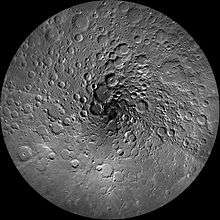Hermite (crater)

Location of Hermite as seen from above the lunar north pole | |
| Coordinates | 86°10′N 93°19′W / 86.17°N 93.32°WCoordinates: 86°10′N 93°19′W / 86.17°N 93.32°W |
|---|---|
| Diameter | 108.64 km |
| Depth | Unknown |
| Colongitude | 110° at sunrise |
| Eponym | Charles Hermite |

.png)
Hermite is a lunar impact crater located along the northern lunar limb, close to the north pole of the Moon. It was first discovered in 1964. To the west is the crater Rozhdestvenskiy, and to the south are Lovelace and Sylvester. Grignard is located directly adjacent to the Southwest. From the Earth this crater is viewed nearly from the side, and it is illuminated by oblique sunlight.
This is a worn, eroded crater with a rugged outer rim that is notched and incised from past impacts. A crater overlies the southwestern rim, and the two formations have merged to share a common interior floor. A pair of small craters lies along the southern part of the rim, and a small crater is also attached near the northern end. The interior floor has been resurfaced, so that it forms a wide plain that is pock-marked by numerous tiny craterlets and low hills. There is a small crater on the floor near the northeastern wall.
In 2009, it was discovered by NASA's Lunar Reconnaissance Orbiter that Hermite is the coldest place recorded in the solar system, with temperatures at 26 kelvin (-413° Fahrenheit, −247° Celsius).[1] For comparison, Pluto's surface only gets down to about 43 kelvin (-382° Fahrenheit, -229° Celsius).[2]
Satellite craters
By convention these features are identified on lunar maps by placing the letter on the side of the crater midpoint that is closest to Hermite.
| Hermite | Coordinates | Diameter |
|---|---|---|
| A | 87°48′N 47°06′W / 87.8°N 47.1°W | 20 km |
External links
- LAC-1 area - Map of northern lunar pole
References
- ↑ Amos, Jonathan (16 December 2009). "'Coldest place' found on the Moon". BBC. Retrieved 17 December 2009.
- ↑ Williams, Ryan (3 January 2006). "Pluto Colder Than Expected". Space.com.
- Andersson, L. E.; Whitaker, E. A. (1982). NASA Catalogue of Lunar Nomenclature. NASA RP-1097.
- Blue, Jennifer (25 July 2007). "Gazetteer of Planetary Nomenclature". USGS. Retrieved 2014-12-05.
- Bussey, B.; Spudis, P. (2004). The Clementine Atlas of the Moon. New York: Cambridge University Press. ISBN 978-0-521-81528-4.
- Cocks, Elijah E.; Cocks, Josiah C. (1995). Who's Who on the Moon: A Biographical Dictionary of Lunar Nomenclature. Tudor Publishers. ISBN 978-0-936389-27-1.
- McDowell, Jonathan (15 July 2007). "Lunar Nomenclature". Jonathan's Space Report. Retrieved 2007-10-24.
- Menzel, D. H.; Minnaert, M.; Levin, B.; Dollfus, A.; Bell, B. (1971). "Report on Lunar Nomenclature by the Working Group of Commission 17 of the IAU". Space Science Reviews 12 (2): 136–186. Bibcode:1971SSRv...12..136M. doi:10.1007/BF00171763.
- Moore, Patrick (2001). On the Moon. Sterling Publishing Co. ISBN 978-0-304-35469-6.
- Price, Fred W. (1988). The Moon Observer's Handbook. Cambridge University Press. ISBN 978-0-521-33500-3.
- Rükl, Antonín (1990). Atlas of the Moon. Kalmbach Books. ISBN 978-0-913135-17-4.
- Webb, Rev. T. W. (1962). Celestial Objects for Common Telescopes (6th revised ed.). Dover. ISBN 978-0-486-20917-3.
- Whitaker, Ewen A. (1999). Mapping and Naming the Moon. Cambridge University Press. ISBN 978-0-521-62248-6.
- Wlasuk, Peter T. (2000). Observing the Moon. Springer. ISBN 978-1-85233-193-1.